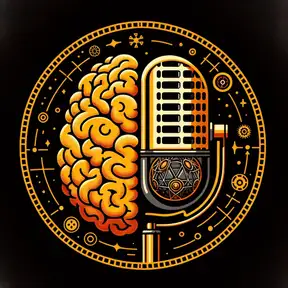The Bystander Effect Revisited: Courage Against “Inevitable” Harm
Unmasking the Bystander Effect: Courage in the Face of Threats
In this episode of PsyberSpace, host Leslie Poston revisits the classic psychology concept of the bystander effect, challenging the common narrative of human apathy in groups. Starting with the infamous case of Kitty Genovese, Leslie digs into how exaggerations shaped public perception and spurred psychological research. The episode highlights recent studies showing that people often do intervene in emergencies, especially under clear and urgent threats, and how community ties and moral identity play pivotal roles in fostering collective courage. It emphasizes the power of individual actions to inspire group responses, debunking the myth of inevitable passivity and urging listeners to prepare and engage in acts of resistance against authoritarian harm.
00:00 Introduction to the Bystander Effect
00:31 The Kitty Genovese Case: Myth vs. Reality
01:55 Reevaluating the Bystander Effect
03:35 Classic Experiments on Group Behavior
05:01 Modern Research and Real-World Evidence
07:49 Community Bonds and Collective Efficacy
16:15 Digital Age: Online Bystander Effect and Resistance
17:33 Historical and Contemporary Examples of Resistance
22:08 Practical Steps for Personal and Community Action
24:25 Conclusion: The Power of Collective Courage
Resources:
Adorno, T. W., Frenkel-Brunswik, E., Levinson, D. J., & Sanford, R. N. (1950). The authoritarian personality. Harper.
Ai, Y., Ismail, R., & Chong, S. T. (2024). A study of the bystander effect in different helping situations. Social Psychology and Society, 15(1), 127–136.
Aquino, K., & Reed, A., II. (2002). The self-importance of moral identity. Journal of Personality and Social Psychology, 83(6), 1423–1440.
Bandura, A. (1999). Moral disengagement in the perpetration of inhumanities. Personality and Social Psychology Review, 3(3), 193–209.
Banyard, V., Mitchell, K. J., Goodman, K. L., & Ybarra, M. L. (2025). Bystanders to sexual violence: Findings from a national sample of sexual and gender diverse adolescents. Journal of Interpersonal Violence, 40(5–6), 1221–1247. (Epub 2024)
Barlińska, J., Szuster, A., & Winiewski, M. (2018). Cyberbullying among adolescent bystanders: Role of affective versus cognitive empathy in increasing prosocial cyberbystander behavior. Frontiers in Psychology, 4, 48.
Batson, C. D., Batson, J. G., Slingsby, J. K., Harrell, K. L., Peekna, H. M., & Todd, R. M. (1991). Empathic joy and the empathy–altruism hypothesis. Journal of Personality and Social Psychology, 61(3), 413–426.
Fischer, P., Greitemeyer, T., Pollozek, F., & Frey, D. (2006). The unresponsive bystander: Are bystanders more responsive in dangerous emergencies? European Journal of Social Psychology, 36(2), 267–278.
Fischer, P., Krueger, J. I., Greitemeyer, T., Vogrincic, C., Kastenmüller, A., Frey, D., Heene, M., Wicher, M., & Kainbacher, M. (2011). The bystander-effect: A meta-analytic review on bystander intervention in dangerous and non-dangerous emergencies. Psychological Bulletin, 137(4), 517–537.
Granovetter, M. (1978). Threshold models of collective behavior. American Journal of Sociology, 83(6), 1420–1443.
Greitemeyer, T., Osswald, S., Fischer, P., & Frey, D. (2007). Civil courage: Implicit theories, related concepts, and Measurement. Journal of Positive Psychology, 2(2)115-119.
Jost, J. T., & Banaji, M. R. (1994). The role of stereotyping in system-justification and the production of false consciousness. British Journal of Social Psychology, 33(1), 1–27.
Kowalski, R. M., Giumetti, G. W., Schroeder, A. N., & Lattanner, M. R. (2014). Bullying in the digital age: A critical review and meta-analysis of cyberbullying research among youth. Psychological Bulletin, 140(4), 1073–1137.
Latané, B., & Darley, J. M. (1968). Group inhibition of bystander intervention in emergencies. Journal of Personality and Social Psychology, 10(3), 215–221.
Latané, B., & Darley, J. M. (1970). The unresponsive bystander: Why doesn’t he help? Appleton-Century Crofts.
Levine, M., & Crowther, S. (2008). The responsive bystander: How social group membership and group size can encourage as well as inhibit bystander intervention. Journal of Personality and Social Psychology, 95(6), 1429–1439.
Manning, R., Levine, M., & Collins, A. (2007). The Kitty Genovese murder and the social psychology of helping: The parable of the 38 witnesses. American Psychologist, 62(6), 555–562.
Miller, D. T., & McFarland, C. (1987). Pluralistic ignorance: When similarity is interpreted as dissimilarity. Journal of Personality and Social Psychology, 53(2), 298–305.
Monroe, K. R. (1996). The heart of altruism: Perceptions of a common humanity. Princeton University Press.
Monroe, K. R. (2008). Cracking the code of genocide: The moral psychology of rescuers, bystanders, and Nazis during the Holocaust. Political Psychology, 29(5), 699–736.
Oliner, S. P., & Oliner, P. M. (1988). The altruistic personality: Rescuers of Jews in Nazi Europe. Free Press.
Philpot, R., Liebst, L. S., Levine, M., Bernasco, W., & Lindegaard, M. R. (2020). Would I be helped? Cross-national CCTV footage shows that intervention is the norm in public conflicts. American Psychologist, 75(1), 66-75 (Epub 2019).
Sampson, R. J., Raudenbush, S. W., & Earls, F. (1997). Neighborhoods and violent crime: A multilevel study of collective efficacy. Science, 277(5328), 918–924.
Scott, J. C. (1987). Weapons of the weak: Everyday forms of peasant resistance. Yale University Press.
Seligman, M. E. P. (1972). Learned helplessness. Freeman.
Snow, D. A., & Soule, S. A. (2009). A primer on social movements. W. W. Norton.
Swedberg, R. (1999) Civil Courage (“Zivilcourage”): The Case of Knut Wicksell. Theory and Society. 28(4), 501-528.
★ Support this podcast ★
In this episode of PsyberSpace, host Leslie Poston revisits the classic psychology concept of the bystander effect, challenging the common narrative of human apathy in groups. Starting with the infamous case of Kitty Genovese, Leslie digs into how exaggerations shaped public perception and spurred psychological research. The episode highlights recent studies showing that people often do intervene in emergencies, especially under clear and urgent threats, and how community ties and moral identity play pivotal roles in fostering collective courage. It emphasizes the power of individual actions to inspire group responses, debunking the myth of inevitable passivity and urging listeners to prepare and engage in acts of resistance against authoritarian harm.
00:00 Introduction to the Bystander Effect
00:31 The Kitty Genovese Case: Myth vs. Reality
01:55 Reevaluating the Bystander Effect
03:35 Classic Experiments on Group Behavior
05:01 Modern Research and Real-World Evidence
07:49 Community Bonds and Collective Efficacy
16:15 Digital Age: Online Bystander Effect and Resistance
17:33 Historical and Contemporary Examples of Resistance
22:08 Practical Steps for Personal and Community Action
24:25 Conclusion: The Power of Collective Courage
Resources:
Adorno, T. W., Frenkel-Brunswik, E., Levinson, D. J., & Sanford, R. N. (1950). The authoritarian personality. Harper.
Ai, Y., Ismail, R., & Chong, S. T. (2024). A study of the bystander effect in different helping situations. Social Psychology and Society, 15(1), 127–136.
Aquino, K., & Reed, A., II. (2002). The self-importance of moral identity. Journal of Personality and Social Psychology, 83(6), 1423–1440.
Bandura, A. (1999). Moral disengagement in the perpetration of inhumanities. Personality and Social Psychology Review, 3(3), 193–209.
Banyard, V., Mitchell, K. J., Goodman, K. L., & Ybarra, M. L. (2025). Bystanders to sexual violence: Findings from a national sample of sexual and gender diverse adolescents. Journal of Interpersonal Violence, 40(5–6), 1221–1247. (Epub 2024)
Barlińska, J., Szuster, A., & Winiewski, M. (2018). Cyberbullying among adolescent bystanders: Role of affective versus cognitive empathy in increasing prosocial cyberbystander behavior. Frontiers in Psychology, 4, 48.
Batson, C. D., Batson, J. G., Slingsby, J. K., Harrell, K. L., Peekna, H. M., & Todd, R. M. (1991). Empathic joy and the empathy–altruism hypothesis. Journal of Personality and Social Psychology, 61(3), 413–426.
Fischer, P., Greitemeyer, T., Pollozek, F., & Frey, D. (2006). The unresponsive bystander: Are bystanders more responsive in dangerous emergencies? European Journal of Social Psychology, 36(2), 267–278.
Fischer, P., Krueger, J. I., Greitemeyer, T., Vogrincic, C., Kastenmüller, A., Frey, D., Heene, M., Wicher, M., & Kainbacher, M. (2011). The bystander-effect: A meta-analytic review on bystander intervention in dangerous and non-dangerous emergencies. Psychological Bulletin, 137(4), 517–537.
Granovetter, M. (1978). Threshold models of collective behavior. American Journal of Sociology, 83(6), 1420–1443.
Greitemeyer, T., Osswald, S., Fischer, P., & Frey, D. (2007). Civil courage: Implicit theories, related concepts, and Measurement. Journal of Positive Psychology, 2(2)115-119.
Jost, J. T., & Banaji, M. R. (1994). The role of stereotyping in system-justification and the production of false consciousness. British Journal of Social Psychology, 33(1), 1–27.
Kowalski, R. M., Giumetti, G. W., Schroeder, A. N., & Lattanner, M. R. (2014). Bullying in the digital age: A critical review and meta-analysis of cyberbullying research among youth. Psychological Bulletin, 140(4), 1073–1137.
Latané, B., & Darley, J. M. (1968). Group inhibition of bystander intervention in emergencies. Journal of Personality and Social Psychology, 10(3), 215–221.
Latané, B., & Darley, J. M. (1970). The unresponsive bystander: Why doesn’t he help? Appleton-Century Crofts.
Levine, M., & Crowther, S. (2008). The responsive bystander: How social group membership and group size can encourage as well as inhibit bystander intervention. Journal of Personality and Social Psychology, 95(6), 1429–1439.
Manning, R., Levine, M., & Collins, A. (2007). The Kitty Genovese murder and the social psychology of helping: The parable of the 38 witnesses. American Psychologist, 62(6), 555–562.
Miller, D. T., & McFarland, C. (1987). Pluralistic ignorance: When similarity is interpreted as dissimilarity. Journal of Personality and Social Psychology, 53(2), 298–305.
Monroe, K. R. (1996). The heart of altruism: Perceptions of a common humanity. Princeton University Press.
Monroe, K. R. (2008). Cracking the code of genocide: The moral psychology of rescuers, bystanders, and Nazis during the Holocaust. Political Psychology, 29(5), 699–736.
Oliner, S. P., & Oliner, P. M. (1988). The altruistic personality: Rescuers of Jews in Nazi Europe. Free Press.
Philpot, R., Liebst, L. S., Levine, M., Bernasco, W., & Lindegaard, M. R. (2020). Would I be helped? Cross-national CCTV footage shows that intervention is the norm in public conflicts. American Psychologist, 75(1), 66-75 (Epub 2019).
Sampson, R. J., Raudenbush, S. W., & Earls, F. (1997). Neighborhoods and violent crime: A multilevel study of collective efficacy. Science, 277(5328), 918–924.
Scott, J. C. (1987). Weapons of the weak: Everyday forms of peasant resistance. Yale University Press.
Seligman, M. E. P. (1972). Learned helplessness. Freeman.
Snow, D. A., & Soule, S. A. (2009). A primer on social movements. W. W. Norton.
Swedberg, R. (1999) Civil Courage (“Zivilcourage”): The Case of Knut Wicksell. Theory and Society. 28(4), 501-528.
Creators and Guests


